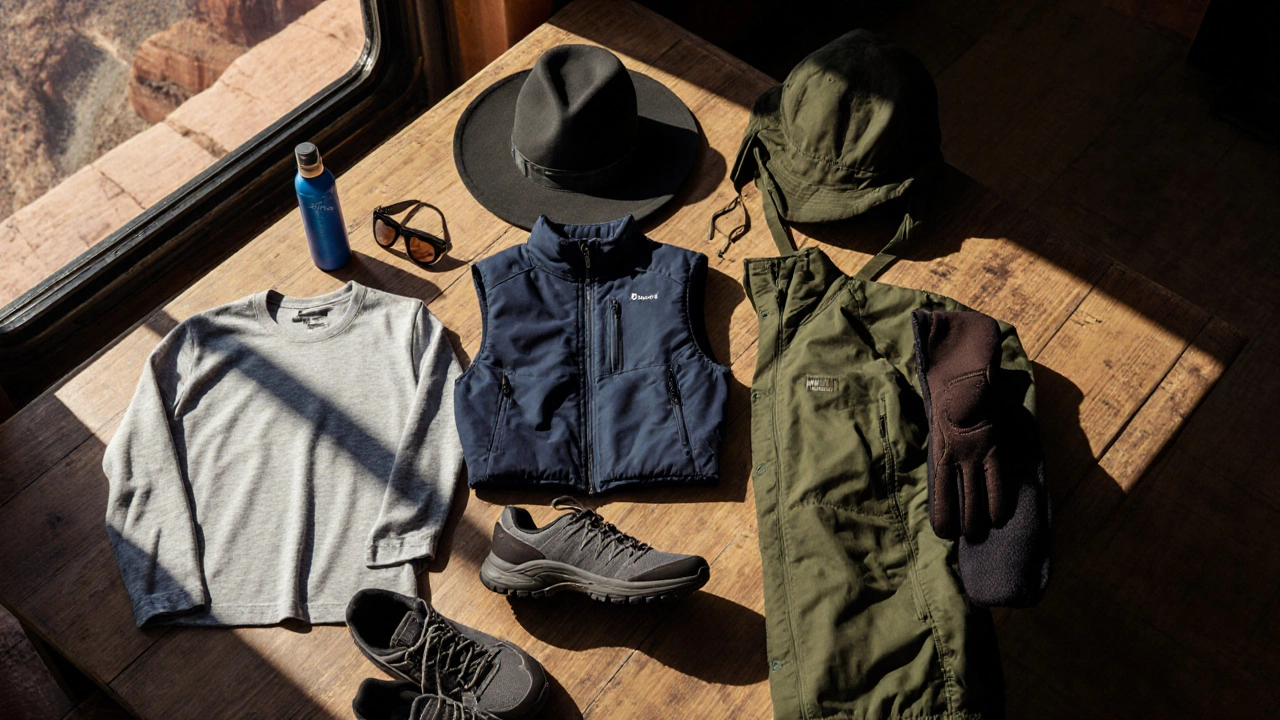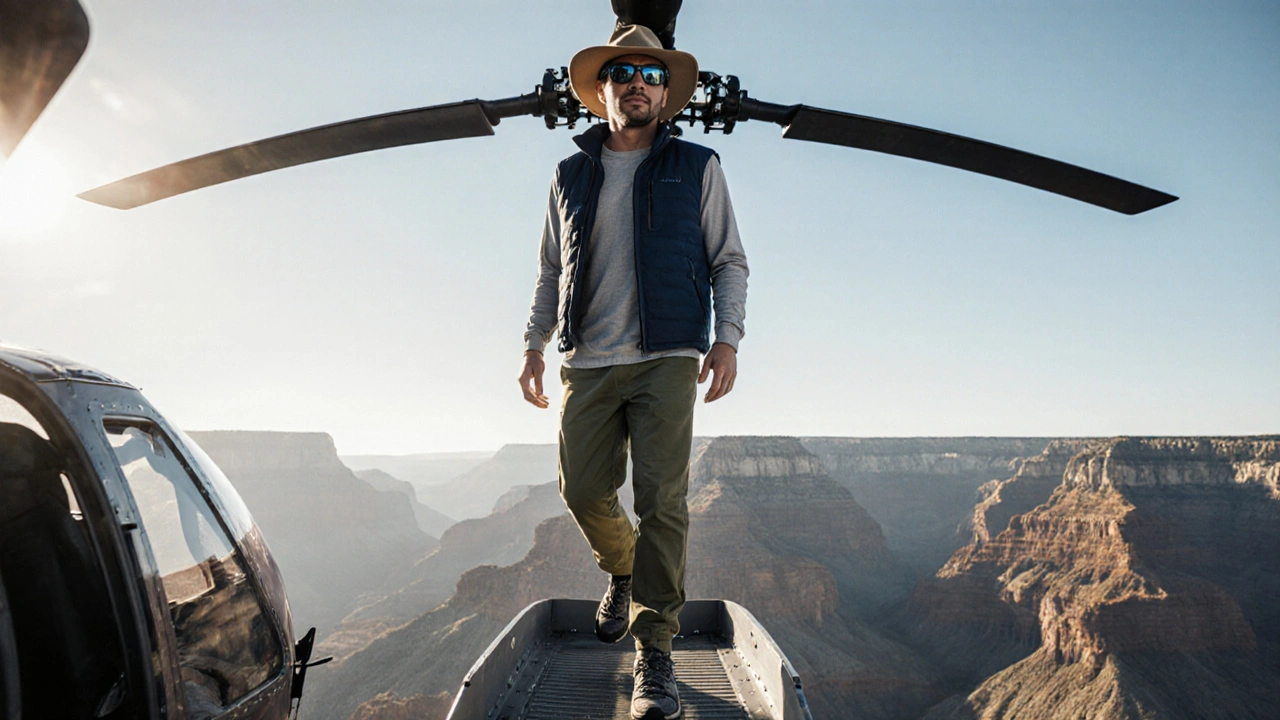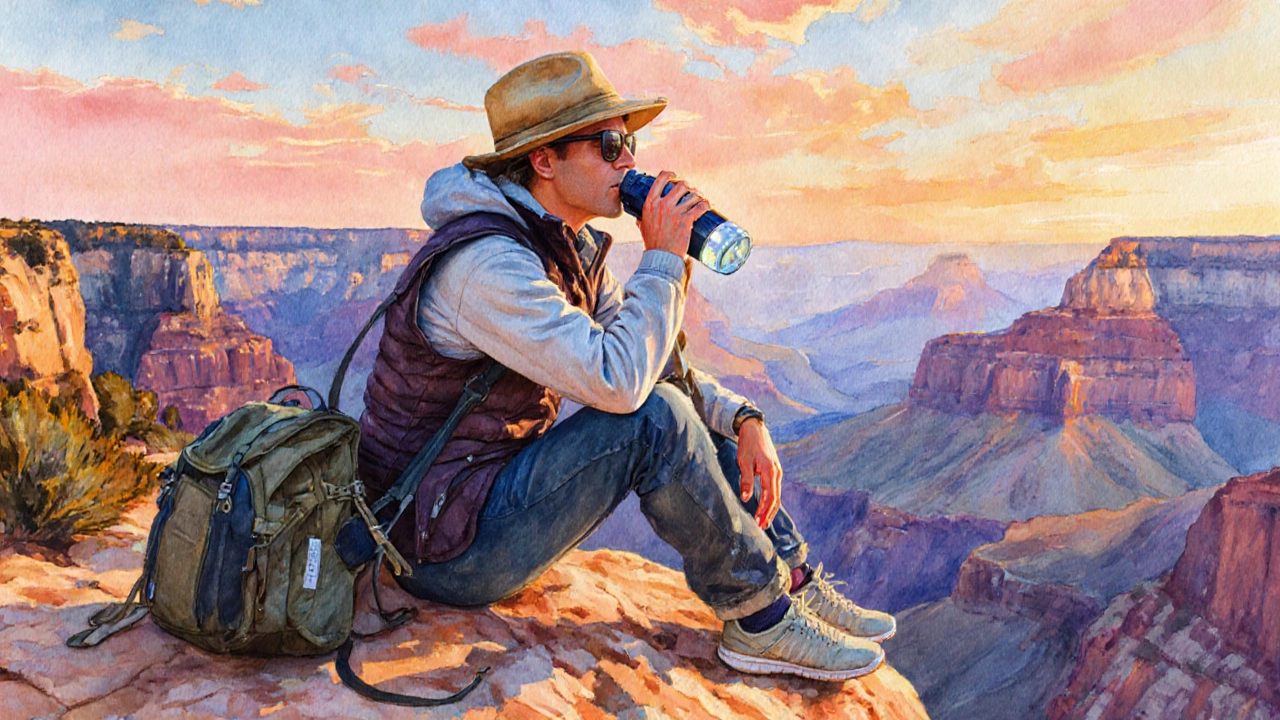What to Wear on a Helicopter Ride to the Grand Canyon - Essential Clothing Guide

Grand Canyon Helicopter Layering Calculator
Calculate your ideal outfit for a Grand Canyon helicopter ride based on temperature and altitude. This tool helps you avoid being too hot or too cold during your flight.
Input Parameters
Tour Tips
When you book a Grand Canyon helicopter tour a short flight over one of the world’s most iconic landscapes, the last thing you want is to feel uncomfortable from the cold wind or scorching sun. Choosing the right outfit can mean the difference between enjoying breathtaking aerial views and wishing you’d stayed on the ground. Below you’ll find a step‑by‑step guide that takes the guesswork out of packing, so you can focus on snapping photos and soaking in the scenery.
Key Takeaways
- Layering is your best friend - start with a moisture‑wicking base, add an insulating middle, and finish with a wind‑proof outer shell.
- Footwear should be sturdy, breathable, and easy to slip on/off; hiking shoes or low‑profile sneakers work well.
- Sun protection is non‑negotiable - wide‑brim hat, UV‑blocking sunglasses, and SPF 30+ sunscreen.
- Bring a small accessory kit (gloves, scarf, camera strap) to stay comfortable and keep gear safe.
- Check the forecast 24‑hours before your flight; temperatures can swing 20‑30°F between the rim and the canyon floor.
Understanding the Canyon’s Unique Climate
The Grand Canyon weather varies dramatically with elevation, time of day, and season. Even in summer, the rim can be 70°F while the canyon floor drops to the 40s. Wind speeds at 2,000feet altitude often reach 15-20mph, creating a noticeable chill. In winter, the wind can feel icy, and occasional snow adds a layer of moisture to the air.
Because a helicopter climbs quickly, you’ll experience a rapid temperature change during the ride. That’s why a flexible clothing system beats a single heavy jacket.
Layering Strategy: From Base to Shell
Think of layers as a three‑piece puzzle:
- Base layer - a lightweight, moisture‑wicking shirt (merino wool or synthetic). It pulls sweat away from skin, keeping you dry.
- Mid layer - an insulating piece such as a fleece or lightweight down vest. It traps warm air without adding bulk.
- Outer shell - a wind‑proof, water‑resistant jacket (soft‑shell or hardshell). Look for breathable fabrics like Gore‑Tex Active.
All three can be easily removed or added between take‑off and landing, letting you adapt on the fly.

Footwear: Comfort Meets Practicality
While you won’t be hiking, you’ll still be on a metal ramp and possibly walking on uneven terrain at the landing site. Choose shoes that:
- Have a snug, supportive fit (no loose laces that can snag).
- Provide a grippy sole for a safe step onto the helicopter.
- Are breathable - avoid heavy boots that trap heat.
Footwear low‑profile, sturdy sneakers or trail shoes are ideal. Pack a thin pair of breathable socks; wool blends prevent blisters if you get a little sweat.
Sun Protection: Shield Your Eyes and Skin
At 1,500feet above the rim, UV exposure is stronger than at ground level. Even on cloudy days, reflected sunlight off the rock can cause burns.
- Hat: A wide‑brim hat (at least 2‑inch brim) keeps the sun off your neck and shoulders. Hat made of quick‑dry material works well.
- Sunglasses: Choose lenses with UV‑400 protection and a wrap‑around design to guard against wind‑blown debris.
- Sunscreen: Apply SPF30+ broad‑spectrum sunscreen 15 minutes before departure; reapply if you plan to stay after the tour.
Essential Accessories
Small items can make a big difference.
- Gloves - lightweight, wind‑proof gloves keep your hands dexterous for camera controls.
- Scarf or neck gaiter - protects your throat from dry, high‑altitude air.
- Camera gear - a compact mirrorless camera with a protective case and a strap that can be secured to your vest.
- Reusable water bottle - stay hydrated; the cabin can be dry.
All accessories should fit into a small daypack or a running‑belt pouch that doesn’t interfere with your harness.

Quick Packing Checklist
| Item | Material / Feature | Why It Helps |
|---|---|---|
| Base layer shirt | Merino wool or synthetic polyester | Moisture‑wick, temperature regulating |
| Mid‑layer fleece | Polartec® or lightweight down vest | Insulates without bulk |
| Outer shell jacket | Wind‑proof, water‑resistant soft‑shell | Blocks wind chill, resists light spray |
| Low‑profile sneakers | Breathable mesh with rubber outsole | Secure grip on metal steps, comfortable |
| Wide‑brim hat | Quick‑dry nylon | Shields face and neck from sun |
| UV sunglasses | Wrap‑around, UV‑400 | Protects eyes from glare and debris |
| Sunscreen SPF30+ | Broad‑spectrum, water‑resistant | Prevents sunburn at high altitude |
| Light gloves | Wind‑proof fleece | Keeps hands warm while staying tactile |
Pro Tips & Common Mistakes
- Don’t overdress. A bulky coat makes it hard to climb into the cabin and can cause overheating once the rotor’s downdraft warms you.
- Check the forecast the day before. Sudden storms can delay flights, and clouds affect visibility - you’ll want a hooded jacket ready just in case.
- Pack a spare pair of socks. Moisture from a sweaty base layer can make feet cold after the ride.
- Avoid cotton. It retains moisture, making you feel colder once the wind picks up.
- Secure loose items. Hats and scarves can blow away in the rotor wash; use a clip or keep them tucked in when boarding.
Putting It All Together: Sample Outfit
Here’s a ready‑to‑wear combination that covers every bullet point above:
- Merino long‑sleeve base layer (light gray)
- Fleece vest (navy)
- Soft‑shell jacket with zip‑away hood (olive green)
- Breathable trail sneakers (gray/black)
- Wide‑brim hat (dark brown)
- Polarized UV sunglasses
- SPF50 sunscreen applied to face, neck, and hands
- Light glove pair tucked into the vest pocket
- Compact daypack with water bottle and camera strap
Adjust colors to your style, but keep the material choices the same - you’ll stay comfortable from take‑off to landing.
Frequently Asked Questions
Do I need a helmet for a helicopter tour?
No. The pilot provides a safety briefing and you’ll be secured with a seatbelt. Helmets are only required for private or air‑tour operators that specifically issue them.
Can I bring a heavy coat and take it off later?
It’s possible, but a bulky coat can be tricky to slip off in the narrow doorframe. A better option is to wear a thin, packable down jacket that fits easily into a daypack.
What temperature should I expect at 2,000feet altitude?
Temperatures typically run 10‑15°F cooler than on the rim. In summer, expect 60‑70°F; in winter, 30‑45°F. Dress in layers to handle the swing.
Is it safe to wear sunglasses during take‑off?
Absolutely. In fact, sunglasses protect your eyes from the bright glare and from any loose debris kicked up by the rotors.
Should I bring a reusable water bottle?
Yes. The cabin air can be dry, and staying hydrated helps you feel comfortable, especially if you’re flying at higher elevations.
By planning your outfit with these guidelines, you’ll stay warm, protected from the sun, and ready to capture the Grand Canyon’s awe‑inspiring vistas. So grab your layered kit, double‑check the weather, and get ready for a flight you’ll remember for all the right reasons. Grand Canyon helicopter tour is an unforgettable experience - dress for it, and you’ll enjoy every minute in the sky.
Seriously, if you think a bulky parka won’t cramp you, you’re dreaming.
Layering isn’t just about looking cool it’s about mastering the dance between wind and warmth, so strip down smartly and add pieces as the altitude climbs.
When you step onto the heli‑pad, the first sensation is the rush of wind that seems to whisper, “you’re about to leave the ground.”
That wind, combined with the rapid ascent, can strip away any misplaced sense of comfort within seconds.
Therefore the base layer should be a breathable, moisture‑wicking fabric that pulls sweat away from the skin rather than letting it cling like a clingy friend.
Merino wool excels here because it regulates temperature both when you’re hot and when the air thins out.
If you prefer synthetics, a polyester blend works just as well, provided it advertises quick‑dry properties.
Over that, the mid‑layer acts as the thermal reservoir, trapping the warm air your body generates while allowing excess heat to escape.
A lightweight fleece or a thin down vest offers a perfect balance between insulation and packability.
As the helicopter climbs, you’ll notice the temperature drop roughly ten to fifteen degrees Fahrenheit for every thousand feet, so having that removable piece is essential.
The outer shell is your final barrier against wind chill and occasional drizzle; a soft‑shell with a DWR (durable water‑repellent) coating will keep you dry without suffocating your skin.
Make sure the shell has ventilation zippers you can open when the sun warms the cabin during a midday flight.
Footwear, often overlooked, should be low‑profile but sturdy; think trail sneakers with a grippy rubber outsole that won’t slip on the metal steps.
Pair the shoes with a thin merino sock to manage moisture and prevent blisters, especially if you’re prone to sweaty feet.
Sun protection cannot be overstated-UV intensity at 1,500 feet is significantly higher than at ground level, so a wide‑brim hat and UV‑400 sunglasses are non‑negotiable.
Apply a broad‑spectrum SPF 30+ sunscreen at least fifteen minutes before boarding, focusing on the face, neck, and hands.
Finally, pack a small accessory kit: lightweight gloves, a neck gaiter, and a compact daypack for water and a camera; all should fit comfortably underneath your vest pocket.
By following this systematic layering strategy you’ll transition from the rim’s warmth to the canyon’s chill without feeling like you’re caught between two weather extremes.
A solid rule of thumb is to avoid cotton entirely-it retains moisture and leaves you colder once the rotor’s downdraft kicks in.
Oh, thank goodness we have that reminder, because I was just about to wear my favorite flannel shirt and hope for the best.
Dress like a mountain, not like a tourist.
That’s a great mindset; just remember a packable insulated jacket can slip into your daypack if you get too warm.
Don’t forget that the Grand Canyon is sacred to many tribes, so wearing respectful colors and modest gear showsCourtesy.